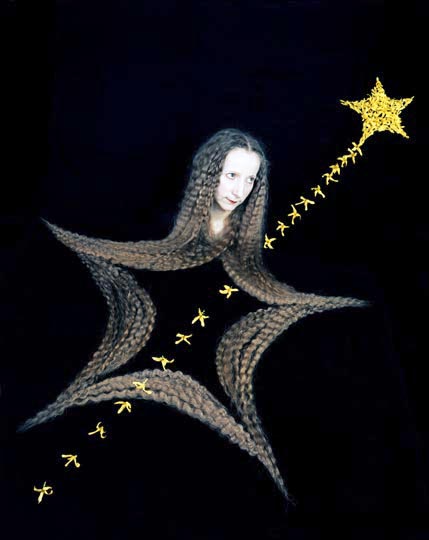
< home < content next: Photoreliefs >
RIMMA GERLOVINA AND VALERIY GERLOVIN
PERHAPPINESS
© 2010, Rimma Gerlovina and Valeriy Gerlovin
PART 2
The yellow Astral Series succeeded the images of fiery roses and gardens of pomegranates. This series comprises mosaics made out of the petals of asters, hardy perennials with a star-shaped structure. It depicts all kind of astral zigzags, bursting in a yellow splendor of sunrises, solar rains, fountains, and a variety of Taoist configurations. The radiant astral light (aster means "star" in Latin) is often seen piercing thin human figures in the manner of medieval artworks.

| Rimma Gerlovina and Valeriy Gerlovin, Astral Star © 1999, C-print |
In addition to the pomegranate and astral photographs, naturally, there are also many with apples, grapes, leaves, seeds, and other supplies of nature. Infanta, after Velázquez (1998), serves as an example of the apple components. The images are connected as an electrical circuit so that the same current flows through each element in sequence.
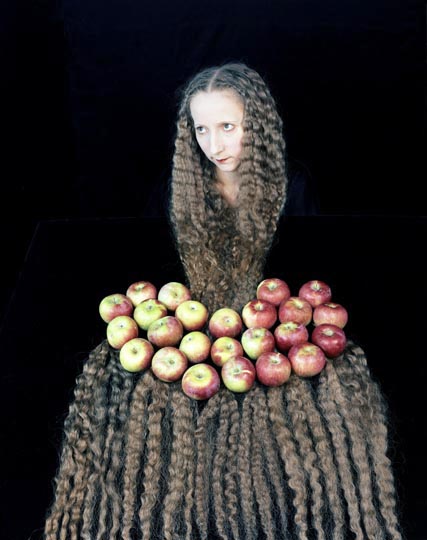
| Rimma Gerlovina and Valeriy Gerlovin, Infanta © 1998, C-print |
Grapes seem to be an organic supplement for the androgynous figure of Sufi (1999), clad in haircloth (sufi literally means "man of wool," his name coming from his garb). Inlaid in grape mosaic, the "curls" of his beard appear much like those on ancient Assyrian bas-reliefs.
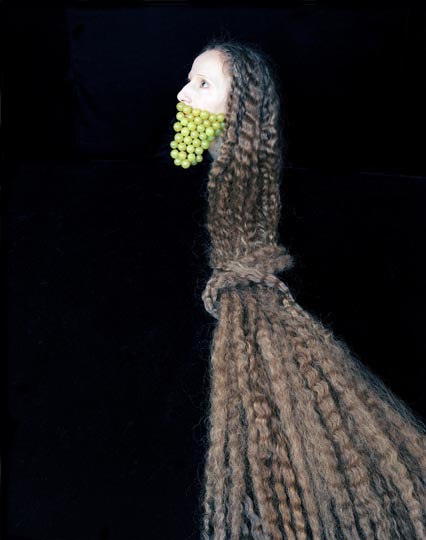
| Rimma Gerlovina and Valeriy Gerlovin, Sufi © 1999, C-print |
Sufi Dance (1999), the subject of which performs in a grape outfit, also touches on the themes of Islamic mysticism, ecstatic aspiration, and meditative "drunkenness." Sufis were forced to hide their visions from the unenlightened under symbols and signs, putting material form on what is immaterial. No doubt, poetry and art can fulfill the same function, helping to distinguish "spiritual emergence from spiritual emergency", provoked by the "great deep" of the social unconscious. The dark void of the background in all of these photographs denotes endless space. Put simply, the black velvet is well suited not only for the multiple exposure technique, but also for creating a geographical and temporal vacuum, the land of nowhere. Maintaining a contemplative atmosphere, such colorless, bottomless blackness displaces a scene from the hectic pace of contemporary life, retaining only the essential.
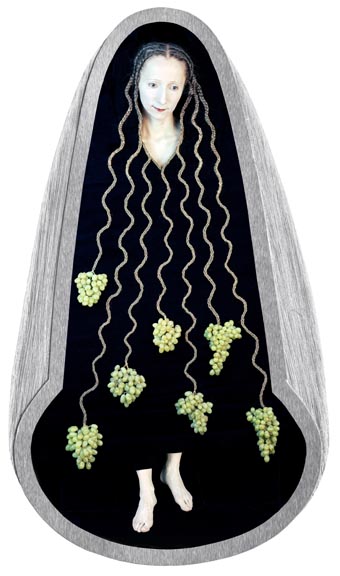
| Rimma Gerlovina and Valeriy Gerlovin, Dionysia © 1997/ 2010, C-print in metal construction |
The progression of the works using fire and other natural elements is closely connected to the theme of the tree of life, which in fact includes all conceivable gradations. In our photography, that tree assumed the most imaginative forms: flaming, flooding, and bleeding; shooting its roots into the sky and its crown into the earth. In the cycle of the seasons, man sees only the chain reaction of the temporary forms of that tree, but not its source. But where is the seed of that tree seed? An obscure Hindu saying comes to mind as an answer: "Only the Self knows the self, only the snake knows its feet." Mountains of scholastic books have been written about that tree of life, mainly by those who were unable to fully comprehend its strata of meaning and therefore enjoined others to do so. Goethe, himself an amateur alchemist, put his counsel in the mouth of Mephistopheles: "Grey is, my young friend, all theory: and green of life the golden tree."(6) So was our approach to the creation of images that seemed to be addressing the same subject, naming it not and stripping it of lofty terminology.

| Rimma Gerlovina and Valeriy Gerlovin, Tree on Hold © 2004, C-prints in metal construction |
The phenomenal world can be revealed through spontaneous artistic reception of the nominal content, and splashed out in visual forms without a transgression of the tree of knowledge law. That tree sends its impulses up and down its branches and its roots, into the various levels of objectivity. And herein lies their correspondence with the spinal-cerebral nervous system rooted in the brain: we all participate in the life of that tree, as generation after generation falls like its foliage; and everybody perceives its meaning according to his or her inner disposition. "Some people either love the tree and hate its fruits or love the fruits and hate the tree" (7); others use it in a ritual "climbing" in their quest for knowledge similar to that of shamans. Perhaps William Blake was correct when he wrote, "a fool sees not the same tree that a wise man sees." (8) Obscure messages from nature are scattered here and there; we merely try to retrieve and shape them through our art, creating naturally like an apple tree creates its apples.
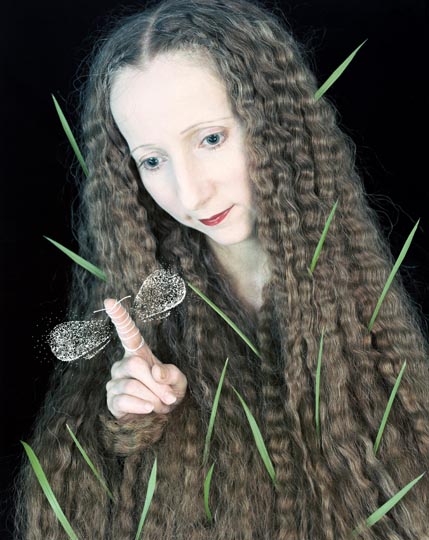
| Rimma Gerlovina and Valeriy Gerlovin, Entomologist © 2002, C-print |
The same are the catcher,
the catch,
and the catching field.
The series of Perhappiness includes several sub-series; the most extensive of them is devoted to showing how conformity and "perhappiness" of existence constantly erect a screen before essential concepts. Entering the new millennium, we literally came upon the veil. That was the main subject of the Veiled Series, depicting different shrouded images. Technically, the works of the series were made by making multiple exposures of a vast array of coverings - curtains, vessels, vapors, "clouds of unknowing" - a technique that came to us much like "manna from heaven" (we'll leave it at that). Akin to Buddhist sand mandalas, the drawings thus created were dispassionately destroyed after the photography sessions, leaving space for a new series of similar ephemerals.
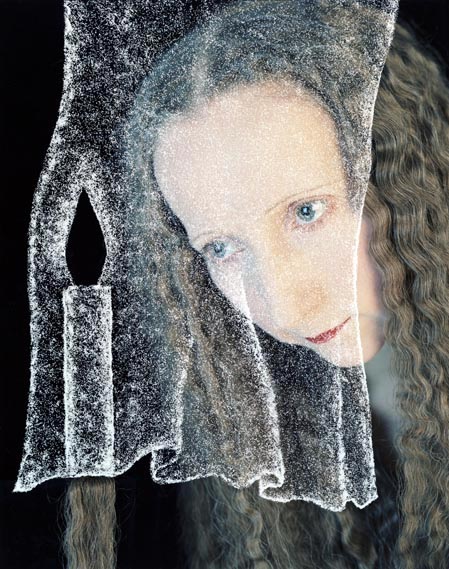
| Rimma Gerlovina and Valeriy Gerlovin, Black Flame © 2001, C-print |
Shrouding the full moon of the face, the translucent veil metaphorically conceals the experience of unveiling the true reality. "None can lift my veil and live," was inscribed on the portal of the now lost ancient temple of Sais. Seventy thousand veils were used to hide God from man in the Sufi tradition. The glory of the invisible world and the essence of introspective union have always been expressed symbolically and under the veil of allegories. Living in today's desacralized world, we still have to deal with the persisting notion of maya, as an ontological fact and not merely a phenomenon of physical life or the human psyche.

| Rimma Gerlovina and Valeriy Gerlovin, Grail © 2001, C-print |
Placing a veil over our subjects and objects, we tried to "dematerialize" the apprehension of physical space and stop the passage of time. For example, the numinous quality of The Grail (2001) becomes a metaphor for the all-pervasive veiled substance of consciousness, of which human consciousness is only one part. In a way, it's similar to the life-giving substance of the legendary grail. Trying to capture the moment of revelation in a goblet of living thought, we showed it revealing and re-veiling at the same time. The theme of the sacral veil is inexhaustible; it suffices to say that in both the Old Testament and many ancient traditions the shroud of silence always preceded the assimilation of knowledge. This motif is depicted in many images from our Veiled Series, including Translucent Book (2001), Three-Handed Scroll (2001), or Flask (2001).
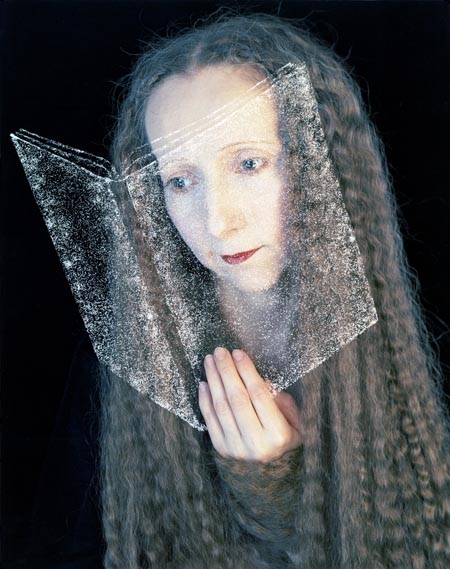
| Rimma Gerlovina and Valeriy Gerlovin, Transclucent Book © 2001, C-print |
Book-in-itself.
It seems that life and creativity always harbor
unan swera bleq uest ion.
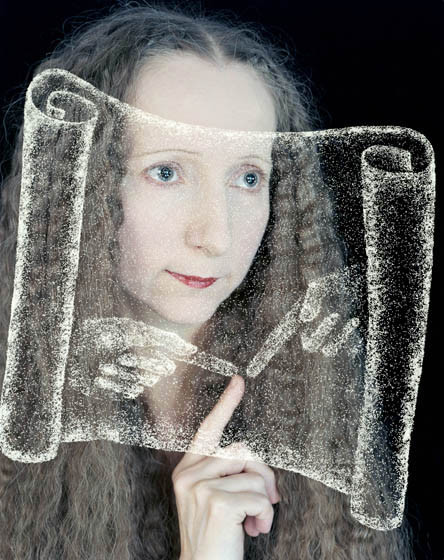
| Rimma Gerlovina and Valeriy Gerlovin, Three Handed Scroll © 2001, C-print |
Three Handed Scroll loops back into the past, to the concept of triunity (Ancient Greek Triskelion, Christian Trinity, Hindu Trimurti, etc.) How does the young generation view it? Three Handed Scroll connects with my desire to find stories or meanings that might steady the disorientation I sense within the world where my subjectivity always exceeds the signifiers placed in its service. I turn to the world of image and language seeking to right the imbalance. I am drawn to Three Handed Scroll because I sense that it is a resting place for me, a point of deferral in my struggle to ascribe meaning and presence within my own game of hide and seek." (Vicki Daiello, the graduate student of Dr. Terry Barrett who courteously sent us her essay.)

| Rimma Gerlovina and Valeriy Gerlovin, Flask © 2001, C-print |
Alchemical Rx:
wrap your opening fire in black tongues,
then wash it in white flames,
and it will bloom with ruby.
Naturally, one might wonder how to "think away" the veil and therefore obtain a glimpse of the otherness. In fact, the original meaning of the word "apocalypse" is "pulling away the veil" - as is the name "Parsifal," which literally means "piercing the veil" - denoting the possibility of seeing the reality of things hidden behind the veil of illusion and misunderstanding. Such altered perception of the world might have a cataclysmic appearance, to use ecclesiastical imagery, like the tearing of the temple veil, beyond which only the priests were permitted to go. In short, under the shade of the tree of knowledge the veiling is inherent and necessary for the provision of eternal archetypes and especially for the distinction between their sacred and profane manifestations.
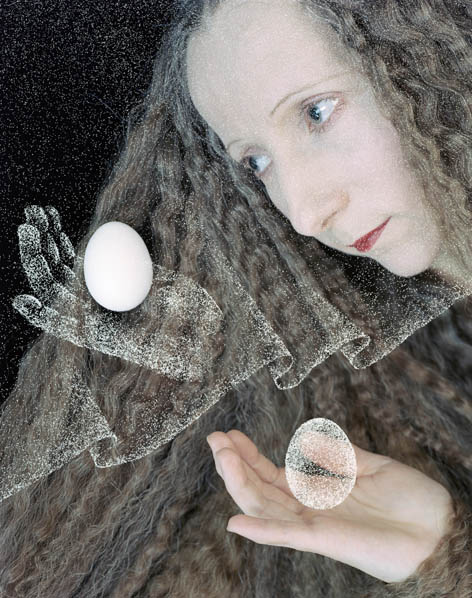
| Rimma Gerlovina and Valeriy Gerlovin, Two Eggs © 2002, C-print |
If aura and veiling can be expressed via contemplative art, science can provide the factual component. For example, a photon, the basic unit of light in physics, can be seen only once, because its detection brings about its annihilation. Could it be that light is seeing, rather than something to be seen? That idea was explored in Black Flame (2001) and Fallen Grapes (2001), Finger Flame (2001) along with several others. Unintentionally, many of our photographs reflect the weirdness of quantum theories, Two Eggs (2002) par excellence. How do you like it when an atom can be on the left and right sides at the same time? But from an observer's perspective, the atom "chooses" to be seen in only one location. In this regard, it should be noted that our photographs have often attracted the attention of scientists and other scholars, who, seeing in our works visual analogues to their theories, wanted to reproduce them in journals and undergraduate textbooks devoted to a range of subjects, from physics and mathematics to psychology and sociology.(9)
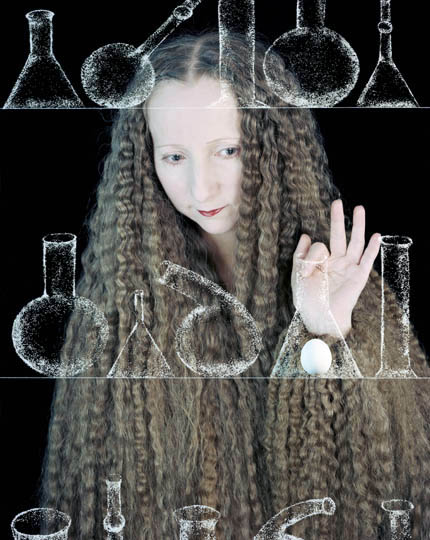
| Rimma Gerlovina and Valeriy Gerlovin, Mini Lab © 2003, C-print |
The Veiled Series is closely connected to the sequence of works in which the egg plays the leading role, as ovum philosophorum: Mini Lab (2003) and Slow Heating (2002), among others. The egg is the end in which the beginning rests, a receptacle for a boundless creative matrix and its dialectical process, which in the seemingly plain language of nature is exemplified in the alternation of the chicken and the egg. Round and "bold," the egg is the embryo of the philosopher's stone, which is neither male nor female, but both. In the Oriental tradition, the second birth, or spiritual elevation, was compared to the process of the hatching of a chick from its eggshell. In many instances, we approached this puzzle visually, using the egg as a symbol of nature's perpetuum mobile, photographing it balancing on a string like a tightrope walker; hanging from a thread in the manner of a pendulum; making nests, cradles, and shoes out of it; or converting it into an ear or a spermatozoon.
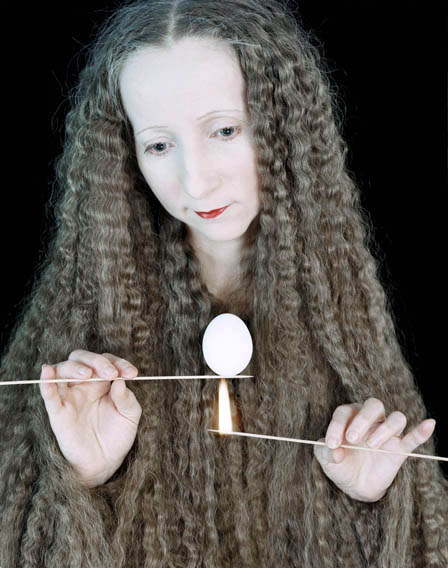
| Rimma Gerlovina and Valeriy Gerlovin, Slow Heating © 2002, C-print |
The magical processing when gentle intuition has to control feelings and mind.
All those transformations and shape-shiftings in our "photomorgana" were arrived at rather intuitively, reflecting the inner state. The ideas behind them might be summarized in the form of the uncomplicated koan we cited in our first article to appear in the unofficial art journal A - Ya, published in 1979.(10) When asked how to avoid wearing clothes and eating food that might interfere with one's spiritual life, the sage replied, "Wear clothes and take food." All of life can be spent answering that simplistically difficult question.

| Rimma Gerlovina and Valeriy Gerlovin, Step Out © 1997, C-print |
Turning to the strata of our visual narration to convey that message, we unwittingly brought into play its three layers - the allegorical (artistic), tropological (ethical), and anagogical (spiritual) - in a manner similar to the principle of sermons. Yet, in contrast to the latter, our visual messages do not pursue a religious apologetic or missionary goal. First and foremost, our work taps into the resources of knowledge that can possibly illuminate inner points of contact. These can be evoked naturally in the minds of individuals who possess memories of them.
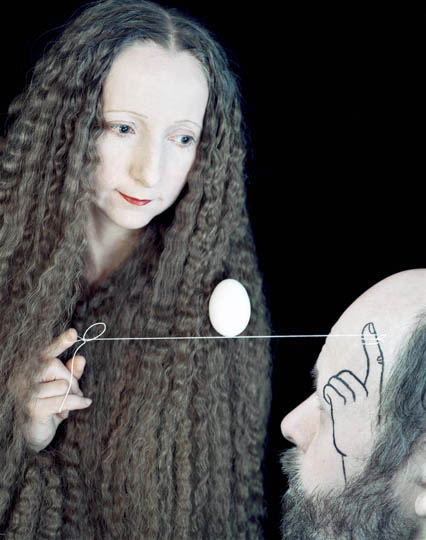
| Rimma Gerlovina and Valeriy Gerlovin, Egg in Transit © 2003, C-print |
In the course of our work, we noticed that light tends to reveal itself to beings in proportion to their capacity. Moving through the densely informative world of picture-writing, one enters its aesthetic biosphere, which no longer resembles the world of everyday consciousness, and thus requires another voicing. Like a sequential melody, our artwork proceeded with time by sequential thought and visualizing of ideas.
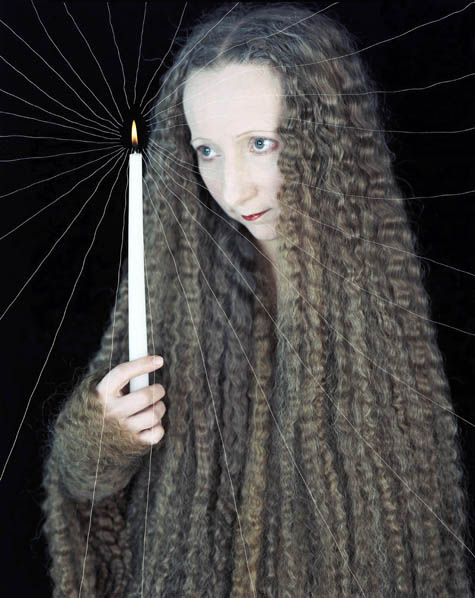
| Rimma Gerlovina and Valeriy Gerlovin, Threads of Light © 2005, C-print |
The latest development of the series Perhappiness features predominantly various kind of wonderworking, especially the sub-series Superstrings, in which wires and strings are used not only as a common thread, but help lend additional dimensionality to otherwise flat photographs. The scientific hypothesis of nonlocality, or the theory of the uncertainty principle, sounds a little bit like perhappiness. Art that gives us the joy of creation speaks a symbolic language of multiple dimensions, which some of us happen to cross, while others perhaps imagine. The wondrous capabilities of photography allow us to reflect the majestic perhappening of life in mental images that take on physical form in the prints.
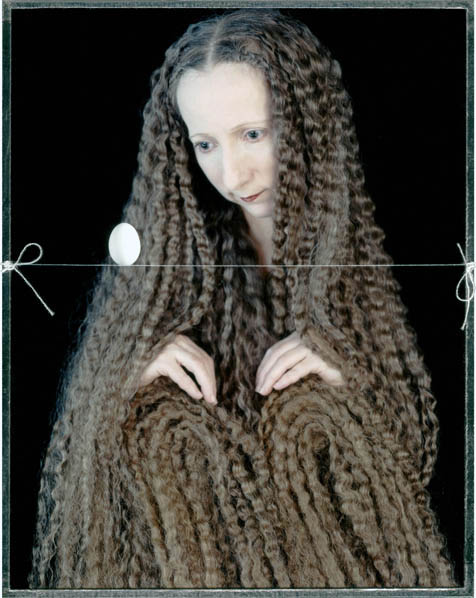
| Rimma Gerlovina and Valeriy Gerlovin, At Glance © 2005, C-print |
FOOTNOTES:
1 Luke 12:7.
2 The plasticity of silence can reveal another inner space when a single word seems to be too many. So the apocryphal saying goes: "the angels sing in silence." The Discourse on the Eighth and Ninth (58:20), in The Nag Hammadi Library, edited by James M. Robinson (San Francisco, Calif.: Harper & Row, 1978), 324.
3 New Angelarium, ed. Ivan Kolesnikov and Sergei Denisov, (Moscow: Moscow Museum of Modern Art, 2007), 266-67. (bilingual publication)
4 Michael Maier, Atalanta fugiens (1617), emblem XXVII, English trans. in the British Library, MS. Sloane 3645, cited in Johannes Fabricius, Alchemy (London: Diamond Books, 1994), 177.
5 Dante Alighieri, La Divina Commedia, Paradiso, Canto XXIII, "Quivi è la rosa in che 'l verbo divinocarne si fece," English trans. Henry Wadsworth Longfellow.
6 Johann Wolfgang Von Goethe, Faust, part 1, "Grau, teurer Freund ist alle Theorie und gruen des Lebens goldner Baum."
7 The Gospel of Thomas (San Francisco, Calif.: Harper & Row, 1984), § 43, 303.
8 William Blake, Proverbs of Hell, from The Marriage of Heaven and Hell (1790), plate 7.
9 Charles Seife, "Do Deeper Principles Underlie Quantum Uncertainty and Nonlocality?" Science (July 2005); Neil deGrasse Tyson, "The Importance of Being Constant (Pi)," Natural History (November 2004).
The college textbooks in question are: John J. Macionis, Sociology (Upper Saddle River, N.J.: Prentice Hall), annual editions 1997-2010; Saul Kassin, Psychology (Upper Saddle River, N.J.: Prentice Hall, 2001); Jeffrey S, Nevid, Abnormal Psychology in a Changing World (Upper Saddle River, N.J.: Prentice Hall, 1997); Robert Blitzer, College Algebra (Upper Saddle River, N.J.: Prentice Hall, 1998); Terry Barrett, Criticizing Photographs: An Introduction to Understanding Images (New York: McGraw-Hill), all editions since 2005.
10 "Rimma Gerlovina and Valeriy Gerlovin," A - Ya (Paris) (1979), no. 1: 16-20.
LINKS:
< home < content next: Photoreliefs >